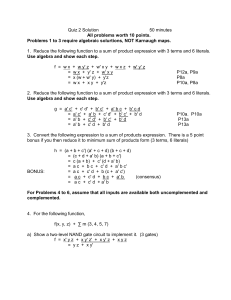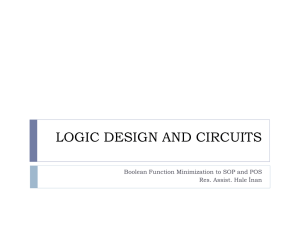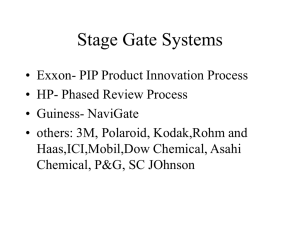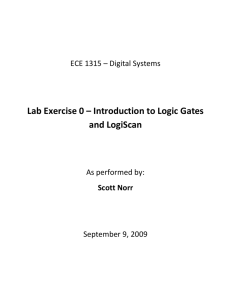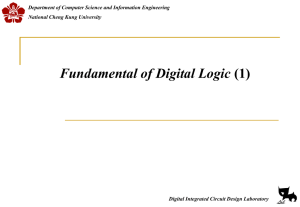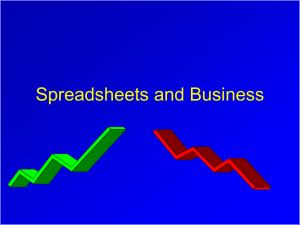Lecture 7
advertisement
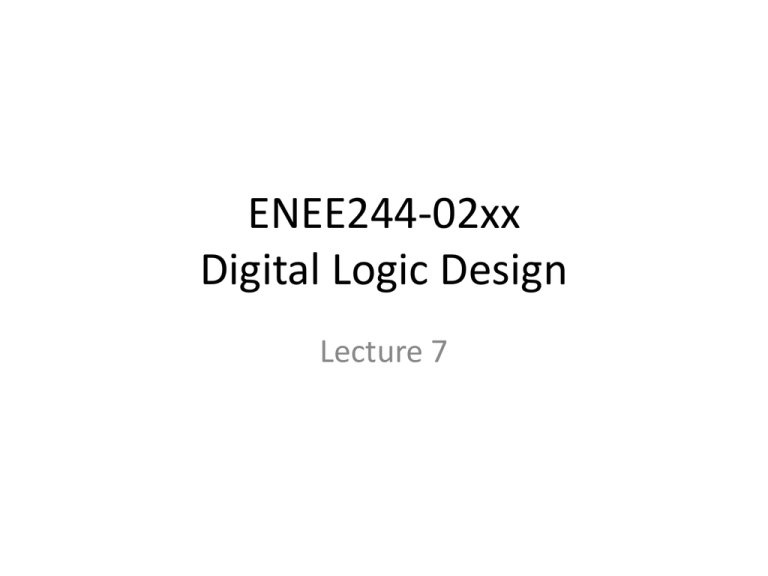
ENEE244-02xx Digital Logic Design Lecture 7 Announcements • Homework 3 due on Thursday. • Review session will be held by Shang during class on Thursday. • Midterm on Tuesday, Sept. 30. First Exam • 8 questions, some with multiple parts • Will cover material from Lectures 1-7 • Including (list on course webpage): – Positional number systems: basic arithmetic, polynomial and iterative methods of number conversion, special conversion procedures. – Signed numbers and complements: r's complement, (r-1)'s complement, addition and subtraction using r's complement, (r-1)'s complement. – Codes: Error detection, error correction, parity check code, Hamming code. – Boolean Algebra: definition, postulates, theorems, principle of duality. – Boolean formulas and functions: canonical formulas, minterm canonical formulas, maxterm canonical formulas, m-Notation, M-notation, manipulation and simplification of Boolean formulas – Gates and combinational networks: various types of gates, universal gates, synthesis procedure, Nand and Nor gate realizations. – Incomplete Boolean functions and don't care conditions: truth table representation, satisfiability don't cares, observability don't cares. – Gate properties: noise margins, fan-out, propagation delays, power dissipation. Agenda • Last time: – Universal Gates (3.9.3) – NAND/NOR/XOR Gate Realizations (3.9.4-3.9.6) – Gate Properties (3.10) • This time: – – – – Some examples of Synthesis Procedure The simplification problem (4.1) Prime Implicants (4.2) Prime Implicates (4.3) Synthesis Procedure Examples Synthesis Procedure • High-level description: A function with finite domain and range. • Binary-level: All input-output variables are binary. Simplification of Boolean Expressions Formulation of the Simplification Problem • What evaluation factors for a logic network should be considered? – Cost (of components, design, construction, maintenance) – Reliability (highly reliable components, redundancy) – Time it takes for network to respond to changes at its inputs. Minimal Response Time • Achieved by minimizing the number of levels of logic that a signal must pass through. • Always possible to construct any logic network with at most two levels under the double-rail logic assumption. – Why? Minimal Component Cost • Assume this is the only other factor influencing the merit evaluation of a logic network. • In general, there are many two-level realizations. • Determine the normal formula with minimal component cost. • Number of gates is one greater than the number of terms with more than one literal in the expression. • Number of gate inputs is equal to the number of literals in the expression plus the number of terms containing more than one literal. • Using these criteria can obtain a measure of a Boolean expression’s complexity called the cost of the expression. The Simplification Problem • The determination of Boolean expressions that satisfy some criterion of minimality is the simplification or minimization problem. • We will assume cost is determined by number of gate inputs. Fundamental Terms • A product or sum of literals in which no variable appears more than once. • Can obtain a fundamental term by noting: 𝑥+𝑥 =1 𝑥⋅𝑥 =0 𝑥+𝑥 =𝑥 𝑥⋅𝑥 =1 Prime Implicants • 𝑓1 implies 𝑓2 (𝑓1 → 𝑓2 ) – There is no assignment of values to the n variables that makes 𝑓1 equal to 1 and 𝑓2 equal to 0. – Whenever 𝑓1 equals 1, then 𝑓2 must also equal 1. – Whenever 𝑓2 equals 0, then 𝑓1 must also equal 0. • Concept can be applied to terms and formulas. Examples • 𝑓1 𝑥, 𝑦, 𝑧 = 𝑥𝑦 + 𝑦𝑧, 𝑓2 𝑥, 𝑦, 𝑧 = 𝑥𝑦 + 𝑦𝑧 + 𝑥z • 𝑓3 𝑥, 𝑦, 𝑧 = 𝑥 + 𝑦 𝑦 + 𝑧 𝑥 + 𝑧 , 𝑓4 (𝑥 + 𝑦)(𝑦 + 𝑧) Examples • Case of Disjunctive Normal Formula – Sum-of-products form – Each of the product terms implies the function being described by the formula – Whenever product term has value 1, function must also have value 1. • Case of Conjunctive Normal Formula – Product-of-sums form – Each sum term is implied by the function – Whenever the sum term has value 0, the function must also have value 0. Subsumes • A term 𝑡1 is said to subsume a term 𝑡2 iff all the literals of the term 𝑡2 are also literals of the term 𝑡1 . • Example: 𝑥𝑦 𝑧, 𝑥𝑧 𝑥 + 𝑦 + 𝑧, 𝑥 + 𝑧 • If a product term 𝑡1 subsumes a product term 𝑡2 , then 𝑡1 implies 𝑡2 . – Why? • If a sum term 𝑡3 subsumes a sum term 𝑡4 , then 𝑡4 implies 𝑡1 . – Why? Subsumes • Theorem: – If one term subsumes another in an expression, then the subsuming term can always be deleted from the expression without changing the function being described. • CNF: (𝑥 + 𝑦)(𝑥 + 𝑦 + 𝑧) • DNF: 𝑥𝑦 + 𝑥𝑦𝑧




